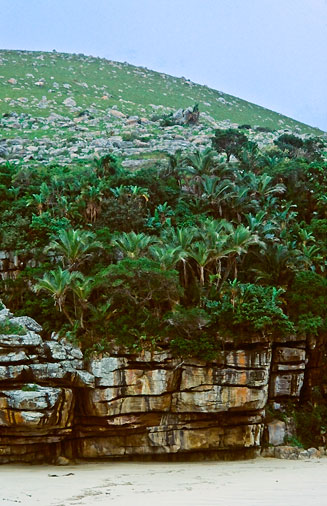|
Jubaeopsis caffra (Pondo coconut, Dwarf Pondoland
palm, Mkambati palm)
Pondo-palm [Afrikaans]; inKomba [Xhosa]
Life
> eukaryotes >
Archaeoplastida >
Chloroplastida
>
Charophyta > Streptophytina > Plantae (land plants)
> Tracheophyta (vascular plants) > Euphyllophyta > Lignophyta (woody plants)
> Spermatophyta (seed plants) > Angiospermae (flowering
plants)
> Monocotyledons > Order: Arecales > Family: Arecaceae
 |
|
|
Jubaeopsis caffra in habitat on the cliffs
above the Mtentu River mouth in the Mkhambati Nature Reserve on the Wild
Coast in Pondoland in the Eastern Cape, South Africa. [photo
Colin Paterson-Jones ©] |
|
This palm can grow to 8 m tall but normally it is less than
5 m.
The pinnate leaves are about 3-4 m long and look similar to those of
Phoenix
reclinata but without spines at the base.
Distribution and habitat
This is the only species in its genus and is endemic to
Pondoland in the Eastern Cape, South Africa, where it is found along the Mtentu
and Msikaba rivers.
Uses by humans
- Fruit are almost round, about 2 cm
in diameter and resemble miniature coconuts with a fibrous outer covering and
the inside containing white 'meat' and a small amount of milk. They also taste
similar to coconuts and despite being so small, are eaten by local people.
- Being a small-sized neat looking palm, it has become popular as an
ornamental tree, especially in the USA.
References
- Palgrave, K.C. and Palgrave, M.C. 2002. Trees of Southern Africa. 3rd
Edition. Struik Publishers, Cape Town.
Text by Hamish Robertson |
